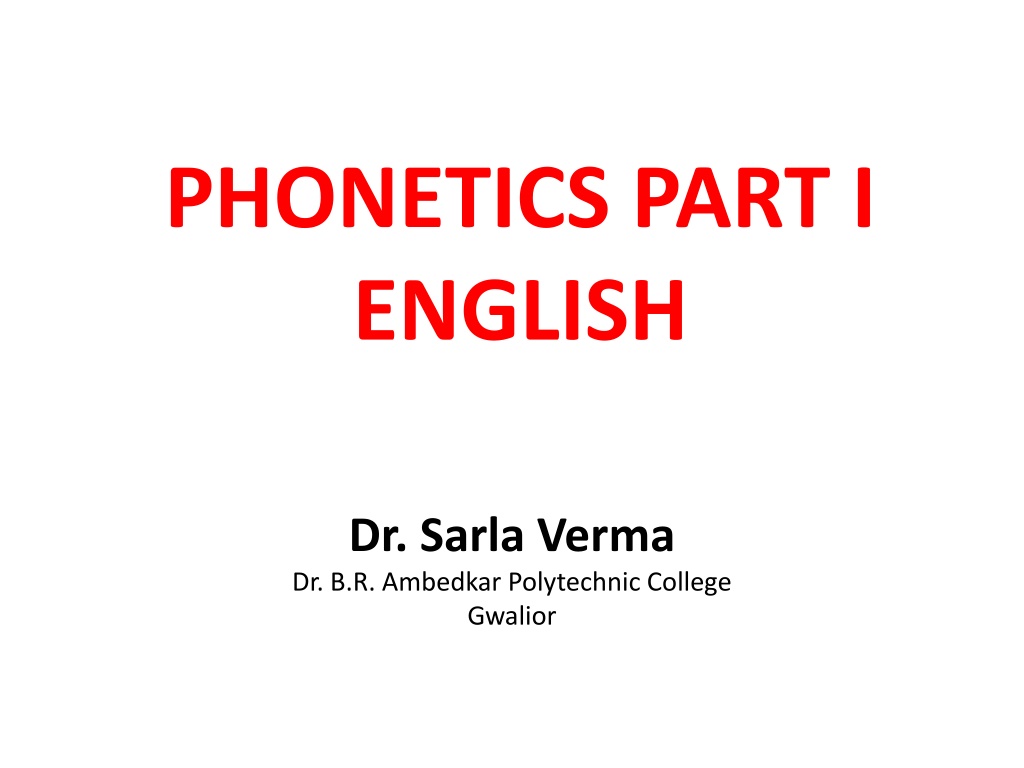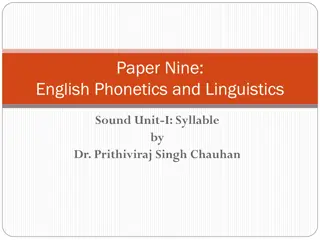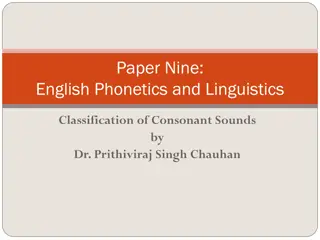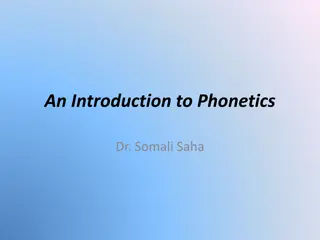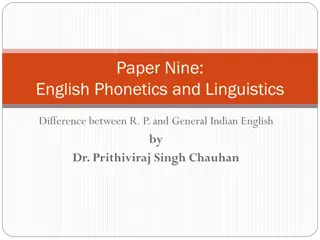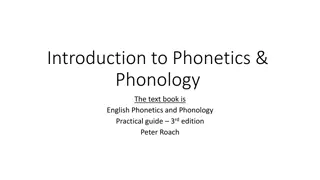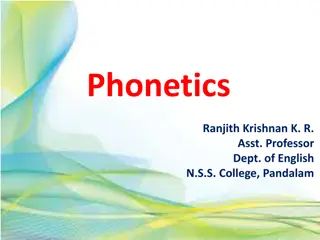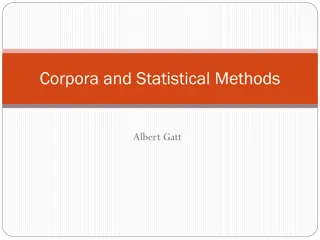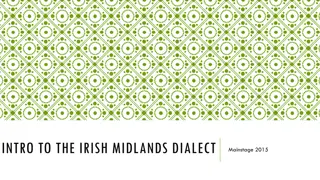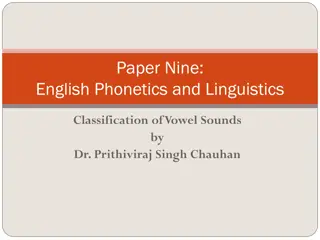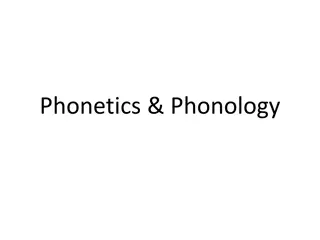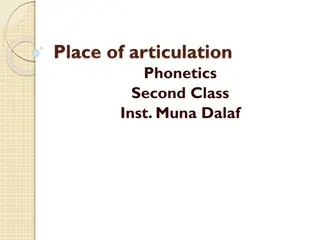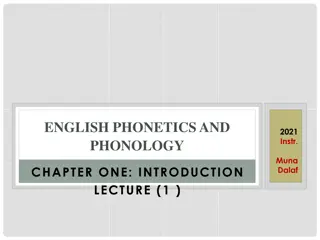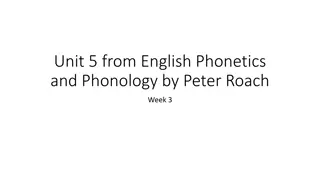Understanding Phonetics in English Language Learning
The study of phonetics plays a crucial role in learning a second language like English, especially for non-native speakers. This content highlights the challenges faced due to native language interference, the importance of phonemic transcription, and the significance of developing a neutral accent. Dr. Sarla Verma's insights shed light on the complexities of mastering English pronunciation and sound systems.
Download Presentation

Please find below an Image/Link to download the presentation.
The content on the website is provided AS IS for your information and personal use only. It may not be sold, licensed, or shared on other websites without obtaining consent from the author. Download presentation by click this link. If you encounter any issues during the download, it is possible that the publisher has removed the file from their server.
E N D
Presentation Transcript
PHONETICS PART I ENGLISH Dr. Sarla Verma Dr. B.R. Ambedkar Polytechnic College Gwalior
Learning a Language Native Language is naturally acquired by listening and imitating during childhood. When it comes to learning a second language, it needs special training and it is not heard except in the classroom. Dr. Sarla Verma 2
The ingrained habits of our native language cause serious conflict or interference with pronunciation, grammar and syntax of the new language. This poses great difficulty for non-native speakers to develop neutral or standard accents that can be correctly understood and properly interpreted. Due to inconsistency in script and pronunciation, English poses considerable difficulty for non native learners. Dr. Sarla Verma 3
Script versus speech sounds cats /s/ ; dogs /z/ ; bushes /iz/ tongue ; sung ; / :/bird ; heard ; herd ; curd tin /t/ ; nation / / /a:/ : far, heart /k/ : cool ; school ; cholesterol ; kick ; quick /j/ : jug ; judge ; ginger /s/ : son ; science ; psychology, certain -gue : argue ; tongue ; sung Dr. Sarla Verma 4
Language and Sound system Spoken language is nothing but clusters of particular sounds in meaningful sequence. Every language has specific sounds which are characteristics of that language. The smallest unit of sound in a language is called a PHONEME. Study of sound system of a language is called PHONETICS. Dr. Sarla Verma 5
Phonetics and English Language Representation of speech with the help of symbols to indicate respective sounds is known as PHONEMIC TRANSCRIPTION. Due to inconsistency in script and speech sounds in English language, Phonetic Transcription offers a great help for non native speakers. Standard Dictionaries are based on phonetic transcriptions approved universally as IPA International Phonetic Alphabet. Dr. Sarla Verma 6
Why Phonetics ? Pronunciations in one language can not be equated with pronunciation of any other language. It is inaccurate to transcribe verbal equivalent of words of one language into another. Every language has characteristic of that language. Teachers who use English as a second language must have a neutral accent free from regional or dialectical influences for training standard (Indian) English in our context. sounds that are Dr. Sarla Verma 7
Speech Mechanism Speech mechanism basically involves breathing correctly and articulating speech organs correctly. Speaking requires breathing fully, breathing at the right time and having power to retain breath. Air is exhaled from lungs with the raising of the diaphragm through the wind pipe or Trachea to pass through Larynx or Voice Box which contains pair of vocal cords that vibrate to produce VOICED SOUNDS. These vibrations can be felt by keeping our fingers at the throat. VOICELESS SOUNDS are produced without vibration of vocal cords. Dr. Sarla Verma 8
Speech Mechanism & Breathing NASAL CAVITY LARYNX/ EPIGLOTTIS/ TRACHEA/ LUNGS UVULA VOICE BOX GLOTTIS WIND PIPE ORAL CAVITY Dr. Sarla Verma 9
Organs of Speech Dr. Sarla Verma 10
Phonetic Symbols In Phonetics each sound is assigned a symbol and each sound is characterized distinctly on the basis of its articulation and its acoustic properties. Sounds can be divided into two major groups, consonants and vowels. Dr. Sarla Verma 11
Vowels Vowels characterize on the basis of articulation, as they are unobstructed in articulation and are produced without friction. are comparatively difficult to Also often they can be articulated in more than one way. IPA is one way; American is another. Dr. Sarla Verma 12
LONG VOWELS 1/5 / :/ far, father, calm, car, farm, garden Dr. Sarla Verma 13
LONG VOWELS 2/5 /u:/ soup, food, use, you, shoes, fool, lose, fruit, mute Dr. Sarla Verma 14
LONG VOWELS 3/5 /i:/ eat, tea, bee, teach, clean,see, sea, free Dr. Sarla Verma 15
LONG VOWELS 4/5 / :/ third, shirt, curd, earth, bird, yearn, furl , girl Dr. Sarla Verma 16
LONG VOWELS 5/5 / :/ tall, claw, hall, saw, thought, yawn, fawn Dr. Sarla Verma 17
SHORT VOWELS 1/7 / / bat, ant, man, fan, sample, anchor Dr. Sarla Verma 18
SHORT VOWELS 2/7 / / or/ / got, lot, spot, caught, chop, hot, not, fox Dr. Sarla Verma 19
SHORT VOWELS 3/7 /i/&/ / ink, kids, very, ship, bin, happy, thirty, it, sit, pin, trim, fit, writ Dr. Sarla Verma 20
SHORT VOWELS 4/7 /e/ or / / bet, get, said, pet, best, leg, head, bed Dr. Sarla Verma 21
SHORT VOWELS 5/7 / / about, ago, alike, saturday, ginger, teacher, driver Dr. Sarla Verma 22
SHORT VOWELS 6/7 / / & /u/ pull, could, put, cook stood, look, took, full book, good, actual Dr. Sarla Verma 23
SHORT VOWELS 7/7 / / Up, nut, gun, luck cup, bud, must, fund, shut, but, nut Dr. Sarla Verma 24
GLIDING VOWELS/ DIPHTHONGS 1/8 / / ice, dive, cry, five, nice, eye, spy, high Dr. Sarla Verma 25
GLIDING VOWELS/ DIPHTHONGS 2/8 /e / bait, gate, make, rate fate, stay, clay, wait Dr. Sarla Verma 26
GLIDING VOWELS/ DIPHTHONGS 3/8 / / boy, joint, toy, oil, join, voice, noise Dr. Sarla Verma 27
GLIDING VOWELS/ DIPHTHONGS 4/8 / / about, shout, now, how, mouth, south Dr. Sarla Verma 28
GLIDING VOWELS/ DIPHTHONGS 5/8 / / no, go, old, sold, ago, toe, load, hold, gold Dr. Sarla Verma 29
GLIDING VOWELS/ DIPHTHONGS 6/8 /e / air, fair, hair, care, share, bear, pair Dr. Sarla Verma 30
GLIDING VOWELS/ DIPHTHONGS 7/8 / / clear, near, hear, beer mere, period, serious Dr. Sarla Verma 31
GLIDING VOWELS/ DIPHTHONGS 8/8 / / poor, tour, cure, newer, fewer, sure Dr. Sarla Verma 32
Front Vowels Front: tongue position examples tea, bee, teach, clean /i:/ / / /e/ or / / / / ink, pin, trim, kids bet, get ,end, bat, ant, man, fan Dr. Sarla Verma 33
Central Vowels examples Tongue position in centre / / Up, nut, gun, must, fund / :/ third, shirt, curd, earth, bird, yearn, furl about, ago, alike, ginger / / Dr. Sarla Verma 34
Back Vowels Back of the tongue examples far, father, calm, got, lot, spot, caught, chop tall, claw, hall, saw / :/ / / / :/ / / /u:/ could, put, stood, cook soup, food, use, you, shoes, move Dr. Sarla Verma 35
Diphthongs : Gliding Vowels -8 /e /as in bait, gate, make, rate / / as in ice, dive, cry, five, nice / / as in boy, joint, toy, oil, join / /as in about, shout, now, mouth, south / / as in no, go, old, sold, ago / / serious / / /e /as in as in clear, near, hear, period, as in poor, tour, cure, newer, fewer air, fair, hair, care, share Dr. Sarla Verma 36
Identify the following sounds Symbols - vowels / :/ and / :/ / /or / / /i/ / / /i:/ / / /u/ /u:/ / / / / / :/or / :/ /e/ and / / / / /e / /e / / / and / / / / /e / / / Give Examples Dr. Sarla Verma 37
Pronounce these words loudly & Repeat 5 times met class- mate mat might lot lawn loan large luck lock lake lack bud buffer bird boat sit syrup seat so think thank but bought writ write read red tour toe tie toy her here hair hire
THANKS Dr. Sarla Verma 9826297033 , 8839216118 dr_sarlaverma@rediffmail.com
